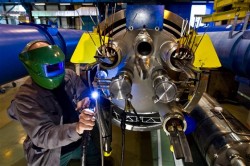

A series of problems forced LHC shutdown (CERN/LHC)
[/caption]On September 19th, CERN announced that the Large Hadron Collider had suffered a major incident, known as a “quench”. An electrical short between two of the superconducting magnets had kick-started a helium coolant leak inside the tunnels housing the accelerator ring. The quench caused the magnets to rapidly heat up, severely damaging them. The violent release of coolant ripped equipment from their concrete anchors, ensuring a huge repair operation would need to be carried out. However, it was a while before engineers were able to access the damage and the news wasn’t good: The LHC would be out of commission until the spring of 2009 at the earliest. That was such a sad day.


In addition to these images, there are suggestions that there may be no particle collisions next year. Although the most recent report doesn’t appear to back up these plans, and replacement parts have started to arrive at the facility (above), it looks like the first collisions probably won’t happen until July 2009 at the earliest (that’s four months later than previously estimated)…


Within the first second, an electrical arc developed and punctured the helium enclosure, leading to release of helium into the insulation vacuum of the cryostat. The spring-loaded relief discs on the vacuum enclosure opened when the pressure exceeded atmospheric, thus relieving the helium to the tunnel. They were however unable to contain the pressure rise below the nominal 0.15 MPa absolute in the vacuum enclosures of subsector 23-25, thus resulting in large pressure forces acting on the vacuum barriers separating neighboring subsectors, which most probably damaged them. These forces displaced dipoles in the subsectors affected from their cold internal supports, and knocked the Short Straight Section cryostats housing the quadrupoles and vacuum barriers from their external support jacks at positions Q23, Q27 and Q31, in some locations breaking their anchors in the concrete floor of the tunnel. The displacement of the Short Straight Section cryostats also damaged the “jumper” connections to the cryogenic distribution line, but without rupture of the transverse vacuum barriers equipping these jumper connections, so that the insulation vacuum in the cryogenic line not degrade.
–Robert Aymar, Status of CERN Activities, page 15.
The first image (pictured above) clearly shows the extent of the concrete damage that occurred during the huge pressure forces generated by the leaking helium, ripping the electromagnets off their supports (the red boxes in the photo) and shattering the floor.
In this second image, the extent of the damage is pretty clear. Assuming the accelerator beam-line used to be straight (unfortunately, there is no “before” picture), the violent displacement of a huge magnet (weighing several tonnes) is obvious.
Later in the presentation, Aymar points out that 5 quadrupole and 24 dipole magnets need to be repaired and around 57 magnets have to be removed to be cleaned. This will be a huge task, one that will last many months. According to one eagle-eyed blogger at High Energy PhDs, a previous report presented a few days before the Aymar report signalled that there may be no high energy particle collisions until 2010. Jorg Winnenger outlined two possibilities for the LHC: 1) Partial operations in 2009, allowing only low-energy particle acceleration to await full-scale repairs through the 2009-10 winter shutdown, or 2) Forget 2009 operations and work toward full-scale experiments in 2010. Aymar’s more recent report did not mention these scenarios, simply stating, “the LHC will restart operation in the next spring.”
Judging by the mixed signals, we’ll have to wait patiently until it is clear as to when the LHC is expected to recover. Either way, it will be a long, painstaking and expensive task that needs to be completed as soon as possible. I really hope we don’t have to wait until 2010 until restart.
Good luck to all involved in the LHC repairs.
Sources: US/LHC Blog, CERN Photos, Stephanie Majewski, High Energy PhDs
How can we explore Saturn’s moon, Enceladus, to include its surface and subsurface ocean, with…
Have you ever wondered how astronomers manage to map out the Milky Way when it's…
NASA astronomers have been continuing to monitor the trajectory of asteroid 2024 YR4. The initial…
Some exoplanets have characteristics totally alien to our Solar System. Hot Jupiters are one such…
Stars form in Giant Molecular Clouds (GMCs), vast clouds of mostly hydrogen that can span…
Let’s dive into one of those cosmic curiosities that's bound to blow your mind: how…